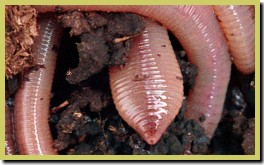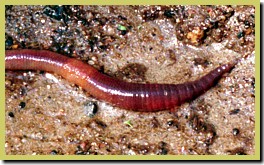
Earthworms!
The Gardener's FriendAs every gardener and farmer knows, earthworms are very beneficial. But, other than that, most people know very little about the lives and biology of these lowly invertebrates. So, here’s a little primer on earthworms. Earthworms belong to the class of invertebrates known as the Oligochaeta. Their soft bodies are arranged in discreet segments. There are about 3000 different species in the world. In Manitoba there are about 10 kinds or earthworms, but most of these are exotic species, having been brought here by European settlers along with their crops and other plants. Earthworms live in tunnels in the soil that they excavate themselves. They use their burrows to move around quickly, both in search of food and to avoid predators. Their tunneling helps to aerate the soil and allows water to penetrate the surface instead of running off. |
||
Worm Biology
Some kinds of earthworms are so plentiful that they form the basis of a $100 million a year industry. Night crawlers (Lumbricus terrestris), or dew worms as they are also known, are harvested as fishing bait. They will cost you about $5 for a dozen in bait stores. Southern Ontario is the center of this industry and every year nearly half a billion (yes, 1/2 billion) night crawlers are collected by hand from golf courses and farmers’ fields for sale across North America. As their name implies, night crawlers come out at night to crawl around on the surface. Workers with lights search for and pick up hundreds of worms a night. Earthworms are hermaphrodites; each individual worm has both male and female sex organs. Most kinds, however, require the sperm of another worm to fertilize their own eggs. To mate, worms must line up against each other, facing opposite directions, then line up their male bits to the respective female bits of the other. After the mutual mating, each worm will produce a capsule containing 2 eggs that will hatch into tiny new worms. Each baby worm will take about a year to grow to adult size; then it could live for as many as 10 years. |
||
|
||
Worms on the Sidewalk
Then what is sending them to the surface when it rains? Well, it’s not necessity that drives them to the surface, it’s desire! Yes, they’re looking for love in all the wet places. At least, that’s one theory. No one’s really studied the phenomenon that closely. The love-in theory suggests that, for worms, getting together is simply a lot easier in the 2-dimensional realm of the ground surface than it would be in the restricting tunnels of the 3-dimensional world of the soil. Heavy rain that wets the ground surface ensures the worms won’t dry out in the pursuit of love. The other, more boring, theory about what worms are doing out in the rain involves dispersal. They may be using the opportunity of having damp ground to move to new feeding areas or leave overcrowded sites. In ClosingEarthworms are interesting creatures in their own right and they are more than just beneficial. All of what we eat originates in the soil. We owe are existence to earthworms and many other lowly creatures, that keep our soils healthy.
More worm articles in NatureNorth: Night Crawler! | Night Crawlers in the Class Room |
||
| You can help NatureNorth produce more great articles with a secure donation through PayPal. Our Google Adsense ads pay our server costs, but that's about it. To learn more follow this link: Support NatureNorth. Thank-you! | |


